Comet NEOWISE was down to magnitude 5.0 or 5.5 by July 30th and fading by about a half-magnitude a day as expected. Finder chart through 0:00 August 5th UT, for the serious.
FRIDAY, JULY 31
■ This evening the waxing gibbous Moon is lined up with Jupiter and Saturn to its left, as shown below. The Moon is just over the Sagittarius Teapot. Covering the Moon with your finger will make the Teapot stars easier to see, assuming your evening sky isn't too bright with summer haze.
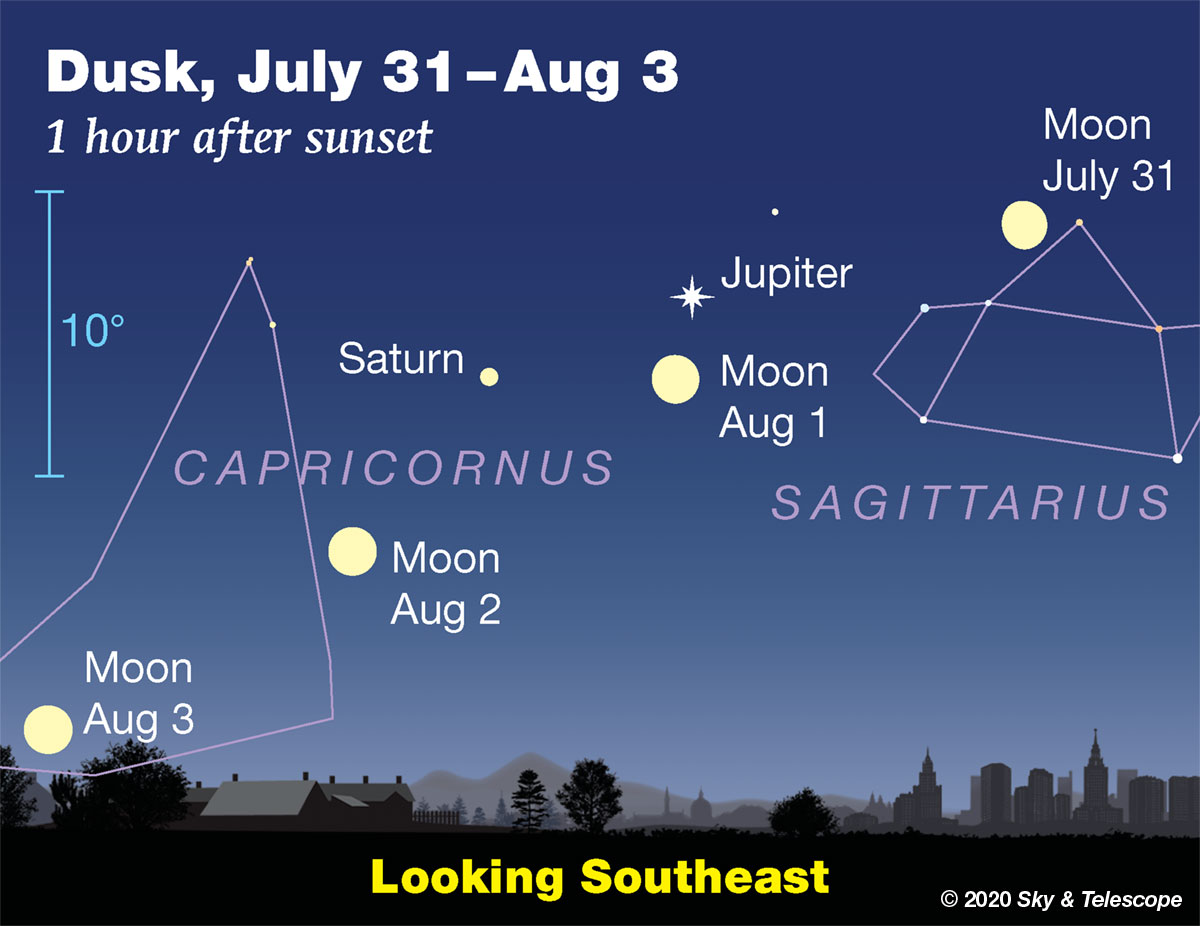
Another way to put this: Planets near a waxing Moon are always past opposition. Planets near a waning Moon are always on their way to opposition.
SATURDAY, AUGUST 1
■ The nearly full Moon this evening forms a triangle with Jupiter and Saturn, more or less as shown above. These sky scenes are always drawn exact for a viewer at latitude 40° north, longitude 90° west, near the middle of North America. They're close enough for the rest of the continent, but don't always expect a perfect match if you're in Boston or Florida or California.
■ Today is Lammas Day or Lughnasadh, one of the four traditional "cross-quarter" days midway between the solstices and the equinoxes. Sort of. Over the centuries since this tradition took root in Europe, the calendar drifted with respect to Earth's position in its orbit. So in 2020, the midpoint between the June solstice and the September equinox actually falls on August 5th: at 1:08 p.m. Eastern Daylight Time (17:08 UT).
That minute is the exact center-balance of astronomical summer: the very top of the circle of the year (as defined by the astronomical seasons, and for the Northern Hemisphere.)
SUNDAY, AUGUST 2
■ The bright Moon at dusk forms a gently curving line with Saturn and Jupiter to its upper right, as shown above.
Later in the evening the line shines higher and turns more level. It's exactly level around 12:30 a.m. daylight saving time, depending on how far east or west you are in your time zone.
MONDAY, AUGUST 3
■ Full Moon (exact at 11:59 a.m. EDT). This evening the Moon rises about a half hour after sunset for most of North America. By nightfall it's shining brightly low in the southeast, in dim Capricornus, to the lower left of Saturn and Jupiter. High above the Moon is Altair.
■ Mars is at perihelion, its closest to the Sun in its 1.88-year orbit. Its closer-than-average solar distance this summer contributes a little to Mars's brightness.
TUESDAY, AUGUST 4
■ The Big Dipper hangs diagonally in the northwest after dark. From its midpoint, look to the right by about three fists at arm's length to find Polaris (not very bright at 2nd magnitude) glimmering due north in the same place it always does.
Polaris is the handle-end of the Little Dipper. The only other parts of the Little Dipper that are even modestly bright are the two stars forming the outer end of its bowl: 2nd-magnitude Kochab and 3rd-magnitude Pherkad. On August evenings you'll find them to Polaris's upper left (by about a fist and a half). They're called the Guardians of the Pole, since they ceaselessly circle around Polaris throughout the night and throughout the year.
WEDNESDAY, AUGUST 5
■ The exact midpoint of summer comes today at 1:08 p.m. Eastern Daylight Time (17:08 UT). This is the halfway point between this year's June solstice and September equinox.
THURSDAY, AUGUST 6
■ Low in the northwest or north at the end of these long summer twilights, would you recognize noctilucent clouds if you saw them? They're the most astronomical of all cloud types, what with their extreme altitude and their formation on meteoric dust particles. And they're fairly rare — though becoming more common in recent years as the Earth's atmosphere changes. See Bob King's Nights of Noctilucent Clouds.
FRIDAY, AUGUST 7
■ Bright Vega passes closest to overhead around 10 or 11 p.m., depending on how far east or west you are in your time zone. How closely it misses your zenith depends on how far north or south you are. It passes right through your zenith if you're at latitude 39° north (Washington DC, Cincinnati, Kansas City, Lake Tahoe). How closely can you judge this just by looking?
Deneb crosses its closest to the zenith almost exactly two hours after Vega. To see Deneb exactly straight up, you'd need to be at latitude 45° north: Portland, Minneapolis, Montreal, southern France, northern Italy.
SATURDAY, AUGUST 8
■ Mars and the waning gibbous Moon rise together around 11 p.m. or so daylight saving time, separated by only 2° or 3° for North America. By midnight they're quite the spectacle shining low in the east. Dawn finds them very high in the south, now as little as 1° apart depending on where you are.
This Week's Planet Roundup
Mercury glimmers low in the east-northeast during dawn. It's bright, growing from magnitude –0.9 to –1.3 this week, but it gets a little lower each morning. Look for it about 30° lower left of brilliant Venus.
Venus (magnitude –4.5, moving from eastern Taurus into the top of Orion's Club) rises in deep darkness more than 1½ hours before the very beginning of dawn. As dawn gets under way, Venus blazes brightly in the east. To its right or lower right is Orion. The brightest star high upper left of Venus is Capella.
In a telescope Venus is a very thick crescent, shrinking this week from 28 to 25 arcseconds tall while waxing from 42% to 47% sunlit — just short of dichotomy.
Mars rises in the east around 11 p.m. daylight saving time, bright (magnitude –1.2) yellow-orange in Pisces like a far-off bonfire. Where will it come up? Watch the horizon below the Great Square of Pegasus. By dawn Mars shines grandly high and bright in the south, a high-blown firespark.
In a telescope this week Mars grows from 14½ to 15½ arcseconds in apparent diameter, as big as it appears at some oppositions! But we're still speeding toward it along Earth's faster orbit around the Sun, and we have a long way to go. Around this year's opposition in early October, Mars will be 22.6 arcseconds wide.
Mars is still very gibbous, 87% sunlit. Look for its white South Polar cap and for subtler dark surface markings. To get a map of the side of Mars facing you at the date and time you'll observe, use our Mars Profiler. The map there is rectangular; remember to mentally wrap it onto the side of a globe. (Features near the map's edges become very foreshortened.)
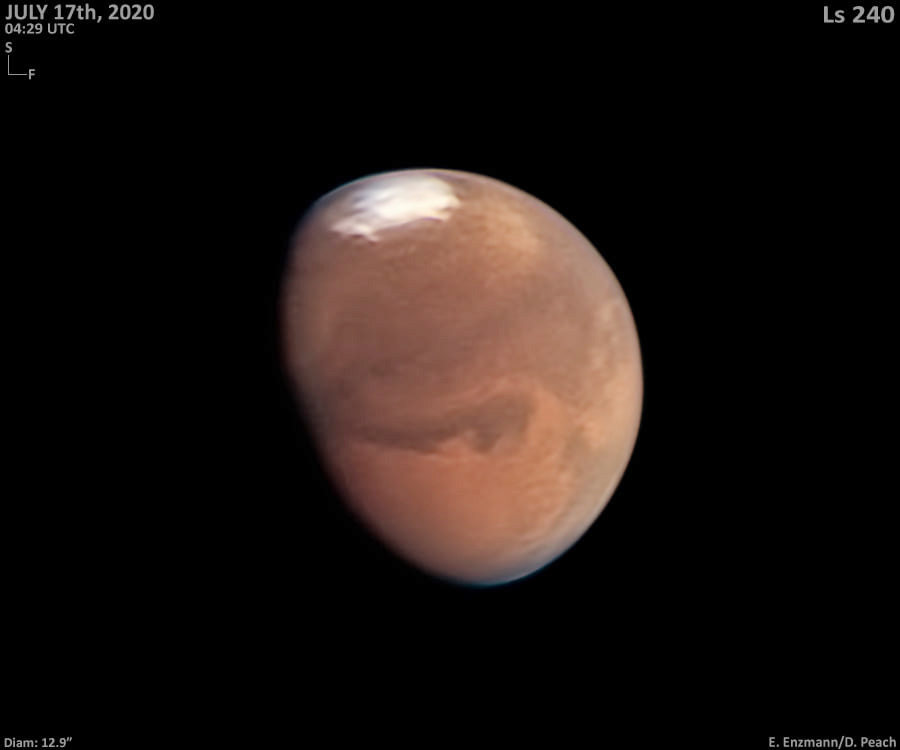
The darkest horizontal streak near center is Sinus Sabaeus, ending on its right ("following") end with two-pronged Sinus Meridiani. Upper right of that is Margaritifer Sinus.
Jupiter and Saturn (magnitudes –2.7 and +0.2, respectively) are a little past opposition. They loom in the southeast in twilight and pass highest in the south around midnight daylight-saving time. Jupiter is brightest; Saturn is 8° to its lower left or left.
Farther to Jupiter's right is the Sagittarius Teapot. High to the planets' upper left, the brightest star is Altair.
Keep up with the telescopic interplay of Jupiter with its moons and their shadows, and find all the transit times of Jupiter's Great Red Spot, in the Celestial Calendar section of the current month's Sky & Telescope.
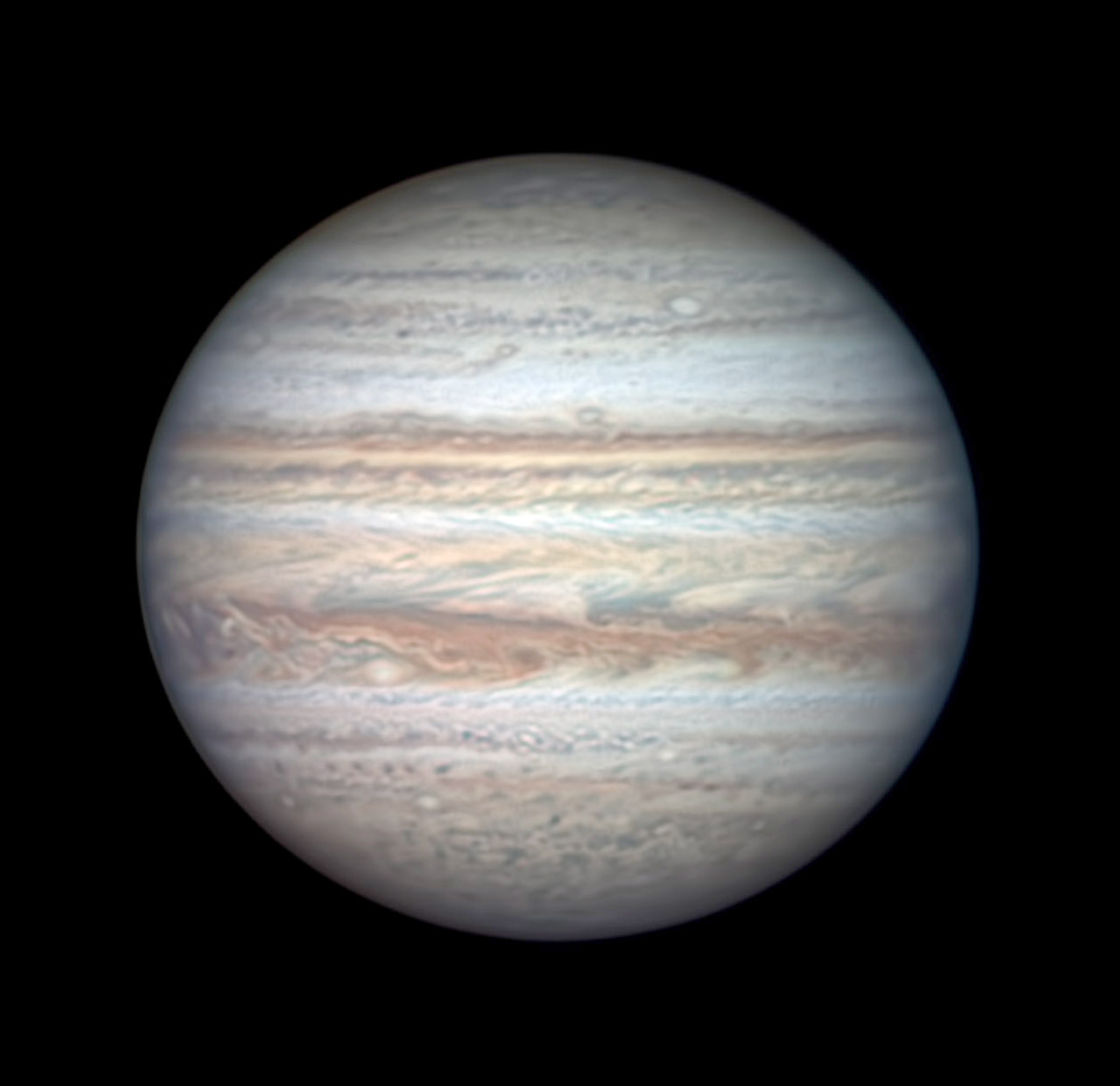
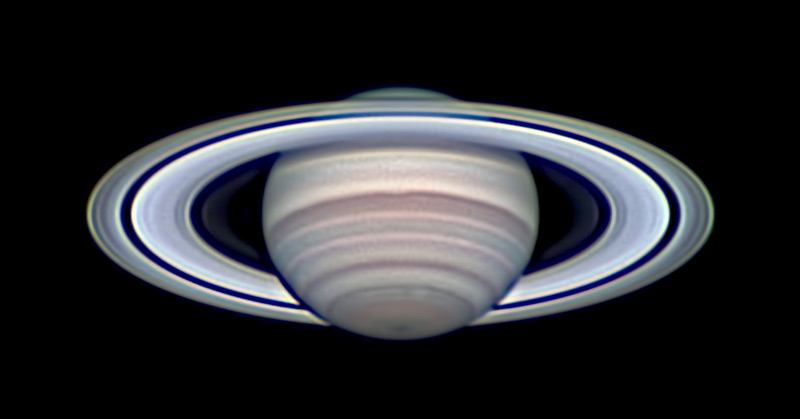
Uranus (magnitude 5.8, in Aries) is high in the east by 2 a.m. daylight-saving time, some 20° to the celestial east of Mars.
Neptune (magnitude 7.8, in Aquarius) is high in the south-southeast at that time, about 30° west of Mars. Finder charts for Uranus and Neptune.
All descriptions that relate to your horizon — including the words up, down, right, and left — are written for the world's mid-northern latitudes. Descriptions that also depend on longitude (mainly Moon positions) are for North America.
Eastern Daylight Time, EDT, is Universal Time (also known as UT, UTC, GMT, or Z time) minus 4 hours.
Want to become a better astronomer? Learn your way around the constellations. They're the key to locating everything fainter and deeper to hunt with binoculars or a telescope.
This is an outdoor nature hobby. For an easy-to-use constellation guide covering the whole evening sky, use the big monthly map in the center of each issue of Sky & Telescope, the essential magazine of astronomy.
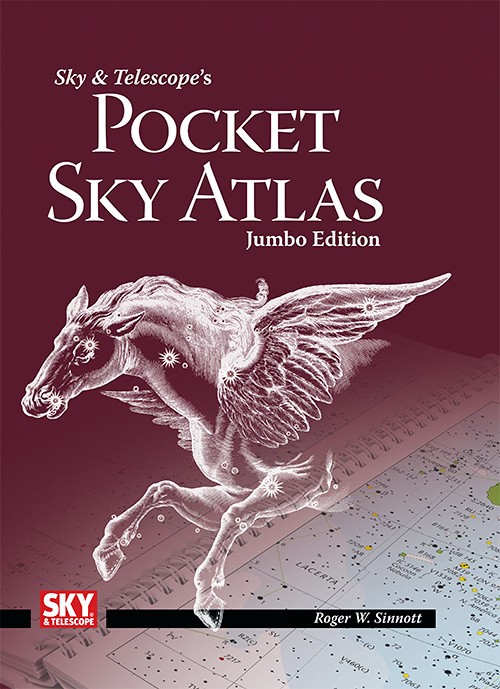
Once you get a telescope, to put it to good use you'll need a detailed, large-scale sky atlas (set of charts). The basic standard is the Pocket Sky Atlas (in either the original or Jumbo Edition), which shows stars to magnitude 7.6.
Next up is the larger and deeper Sky Atlas 2000.0, plotting stars to magnitude 8.5; nearly three times as many. The next up, once you know your way around, are the even larger Interstellarum atlas (stars to magnitude 9.5) or Uranometria 2000.0 (stars to magnitude 9.75). And read how to use sky charts with a telescope.
You'll also want a good deep-sky guidebook, such as Sky Atlas 2000.0 Companion by Strong and Sinnott, or the bigger (and illustrated) Night Sky Observer's Guide by Kepple and Sanner.
Can a computerized telescope replace charts? Not for beginners, I don't think, and not on mounts and tripods that are less than top-quality mechanically, meaning heavy and expensive. And as Terence Dickinson and Alan Dyer say in their Backyard Astronomer's Guide, "A full appreciation of the universe cannot come without developing the skills to find things in the sky and understanding how the sky works. This knowledge comes only by spending time under the stars with star maps in hand."
![]() Audio sky tour. Out under the evening sky with your
Audio sky tour. Out under the evening sky with your
earbuds in place, listen to Kelly Beatty's monthly
podcast tour of the heavens above. It's free.
"The dangers of not thinking clearly are much greater now than ever before. It's not that there's something new in our way of thinking, it's that credulous and confused thinking can be much more lethal in ways it was never before."
— Carl Sagan, 1996
"Facts are stubborn things."
— John Adams, 1770
 16
16








Comments
Rod
July 31, 2020 at 9:16 am
mary beth, New Jersey Eclipse Fan. It has not been good stargazing lately for me here in Maryland. Temps running 90-95 F with periodic T-storms moving through in the evenings. However, yesterday was pretty good 🙂 Thursday morning, was a fun and eventful morning for me. NASA Perseverance rover launched near 0750 EDT. I watched live on NASA TV on the web. While watching the launch and coverage, I enjoyed some solar observations of sunspot AR2767 and AR2768 using my telescope. Earlier, about 0115 EDT, Mars was ascending very bright in ESE sky, easily visible to unaided eyes before I went to bed.[Observed 0820-0845 EDT. "Sunspots AR2767 and AR2768 are both members of Solar Cycle 25. We know this because of their magnetic polarity, which is reversed compared to sunspots from old Solar Cycle 24. Credit: SDO/HMI" (spaceweather.com) Excellent views of sunspots AR2767 and AR2768 this morning using 90-mm refractor with Orion Sirius 25-mm plossl. Celestron #12 Yellow filter too. Distinct spots and the plage extending away from AR2768 is perhaps close to 10 Earth diameter in length. AR2767 still about Earth size. I was out 0820-0845 EDT this morning, about 0.42 hours. At 0750 EDT this morning, NASA launched Mars Perseverance rover mission to Mars, https://www.nasa.gov/multimedia/nasatv/index.html#public I watched and monitored too and enjoyed some sunspot observing at the same time. Signal acquisition again from the spacecraft at 0917 EDT and the rover is on its way to Mars now. Landing 18-Feb-2021 on Mars.]
I hear the spacecraft is in safe mode now due to some possible problems. Hope you folks are getting better weather for stargazing---Rod
You must be logged in to post a comment.
New Jersey Eclipse Fan
July 31, 2020 at 7:43 pm
Thanks for the "personal" touch. The weather here is about the same as in Maryland, it just arrives a little later. My family members are definitely amateurs when it comes to stargazing, as we only have binoculars at our disposal. My son took our telescope with him when he moved to Northern California, but he temporarily(?) moved back home recently and left a number of things in storage out west, including the telescope. We kind of lost interest in Comet NEOWISE, both because it was fading and the novelty wore off. And although it's generally accepted that this was the best comet to view with the unaided eye since Hale-Bopp, it was nevertheless a bit disappointing through our binoculars, due to light pollution. The magnificent photos here and elsewhere set us up for "failure," but it was still worth it. From my wife's perspective, NEOWISE lacked the "wow" factor that was achieved three years ago when we were in Tennessee for the total solar eclipse, but I guess the comparison is unfair. She does come outside with me to watch the ISS flyovers, however! In fact, there's a -3.3 magnitude one scheduled to begin in our NW sky at ~9:25PM tonight--peaking at an altitude of 52° in the NNE--so we're planning to look up! It's supposed to be visible a good five minutes total before disappearing into Earth's shadow at 23° in the ESE sky.
You must be logged in to post a comment.
mary beth
August 1, 2020 at 11:51 am
Hi Rod and NJEF!
Rod, I figured something was up since you had not posted anything. Hopefully you’ll have better weather next week. It’s been raining every day here for about 10 days I think. It clears off somewhat at night so I have been able to enjoy the night sky at least 50% of the time. Hoping for a clear night for the full moon. Just like New Jersey Eclipse Fan, Houston was a dud for viewing the comet. And also I am a big fan of the ISS. A matter fact my neighbor and I always make a point to meet outside with a soft drink and a snack and watch together! Hope everyone has a nice weekend and a nice start to August! Happy Lammas Day!!
You must be logged in to post a comment.
mary beth
August 3, 2020 at 12:43 pm
Welcome to the forum! Can you please tell us what time and what direction you saw the object? Hopefully we can help!
You must be logged in to post a comment.
mary beth
August 3, 2020 at 12:49 pm
Oops...Replied on the wrong comment so I posted it again below the new member’s question. Dang iPad !! it’s self scrolling!!
You must be logged in to post a comment.
Mistry
August 2, 2020 at 6:24 am
Hi all I'm new here. On 1st August 2020 I noticed a red star not sure if it was Mars. I would like to share a pic but dont know how to. Look forward to hear from the group soon. X
You must be logged in to post a comment.
mary beth
August 3, 2020 at 12:48 pm
Welcome to the forum! Can you please tell us what time and what direction you saw the object? Hopefully we can help!
You must be logged in to post a comment.
Mistry
August 3, 2020 at 1:28 pm
Thank you for your reply. It was mid night south from London.
You must be logged in to post a comment.
Jakob
August 3, 2020 at 5:17 pm
http://www.Heavens-above.com is a superb webbsite. Take a look! (-:
You must be logged in to post a comment.
Rod
August 3, 2020 at 2:03 pm
Mistry, I used Stellarium 0.20.2 and checked 01-Aug-2020 near 0010 local time for London. Mars was visible in E sky but lower, perhaps 8-9 degrees up and bright too, apparent magnitude -1.09. Arcturus, a red giant star was bright, 18-19 degrees elevation angle and in the W sky. Apparent magnitude 0.15. Mars was in Pisces and Arcturus in Bootes.
You must be logged in to post a comment.
Rod
August 3, 2020 at 2:05 pm
Mistry, to be safe here. Saturn, Jupiter, and the Moon were in the southern sky for London location too. They were near the ecliptic in Sagittarius, some 11-18 degrees or so evelation.
You must be logged in to post a comment.
mary beth
August 3, 2020 at 6:30 pm
Could have been Antares?
You must be logged in to post a comment.
Rod
August 3, 2020 at 8:53 pm
mary beth, may be. Stellarium 0.20.2 showed Antares setting near 0020/0021 local time at London so if observed, Antares would be very low in south sky near the horizon. Depending upon direction and elevation angle Mistry was viewing, Mars or Arcturus may be the better choice 🙂 I am now getting ready for the tropical storm arriving early tomorrow morning. No stargazing. Perhaps 4-6 inches of rain and winds blowing 50 mph. I did plenty of grass cutting today and weed whacking, cleaning out drainage areas too 🙂
You must be logged in to post a comment.
mary beth
August 4, 2020 at 1:48 am
Oh Rod, please keep us up-to-date on how you’re doing through the storm. Hopefully you won’t get any damage and it will pass quickly. I’ve been through five hurricanes and they are not fun at all! Oddly we are predicted to have clear skies so I will let you know if I see anything interesting. Stay safe and look forward to an update from you.
You must be logged in to post a comment.
Rod
August 4, 2020 at 11:09 am
mary beth. Good at my location now. Isaias flew by the Chesapeake Bay at 32 knots moving NE or so. In 3-4 hours, out of my location now but 5 inches of rain for me and in Leonardtown MD, 9 inches farther south. Trees down, local flooding around in different areas, some local flood rescue operations underway near me on the news but I am good. Will do storm survey damage later---Rod
You must be logged in to post a comment.
mary beth
August 4, 2020 at 1:38 pm
I am very glad to hear you are OK. Thank you for the update. I wonder how long it will take the pasture to dry out so you can go out and stargaze? stay safe!
You must be logged in to post a comment.
You must be logged in to post a comment.